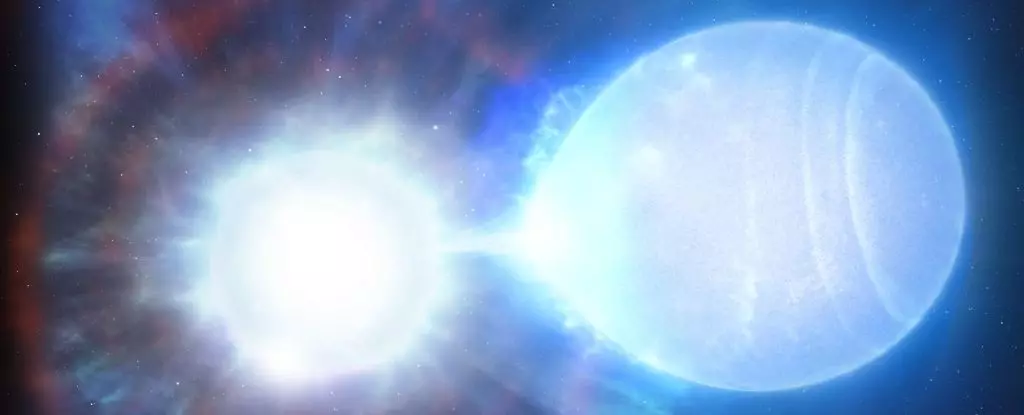In the vast expanse of the universe, every star, no matter how brilliant and eternal it seems, is destined to meet its end. This concept holds a profound significance in our understanding of stellar evolution and the life cycle of celestial bodies. The narrative surrounding the lifespan of stars invites a deeper reflection on not just their brilliant beginnings in stellar nurseries, but also their inevitable demise. Each star’s death leads to ecological changes in the cosmos, reshaping the fabric of space and time. The tale of a binary star system, located approximately 150 light-years from Earth, further emphasizes this cosmic truth. In a bizarre twist of irony, while these stars are destined for destruction, their eventual explosion will illuminate the sky—an awe-inspiring Type Ia supernova that serves as a measuring tool for cosmic distances.
The Enigmatic Nature of White Dwarfs
White dwarfs are fascinating remnants of stars that have exhausted their nuclear fuel, leaving behind extraordinarily dense cores. While mainstream stars ignite with the fire of hydrogen fusion throughout their life, white dwarfs exist in a state of cooling embers. Each white dwarf carries the mass of up to 1.4 solar masses compressed into a volume no larger than that of Earth, held together by gravity’s unyielding pull. This critical threshold is known as the Chandrasekhar limit, a defining boundary that governs the fate of these stellar remnants. When white dwarfs exceed this limit through accretion from their companions, the stage is set for a cataclysmic explosion, marking the transformation of these fading embers into brilliant cosmic fireworks.
Unveiling the True Nature of Type Ia Supernovae
Type Ia supernovae play a crucial role in astrophysics; they are not just stunning celestial events but also vital indicators of cosmic distances. It has long been theorized that these explosive phenomena arise from white dwarfs in binary systems, yet definitive evidence remained elusive. Astrophysicists have speculated on the underlying mechanisms, hypothesizing that two white dwarfs might consolidate their masses to surpass the Chandrasekhar limit. Recent advancements delivered a paradigm shift when researchers identified a binary star system capable of producing a Type Ia supernova on a timeline congruent with the universe’s age. This groundbreaking discovery not only solidifies our understanding of supernova progenitors but also presents both an answer and a new hypothesis regarding the rate of Type Ia supernovae populating the Milky Way.
The Cosmic Dance of WDJ181058.67+311940.94
Dubbed WDJ181058.67+311940.94, this binary system has enthralled astronomers with its unique characteristics. With a combined mass approximately 1.56 times that of our Sun and an orbital period exceeding 14 hours, it encapsulates the essence of celestial connection. The stars are positioned closely, separated by a mere fraction of the Earth-Sun distance, which sets the stage for their inevitable spiral toward destruction. As they orbit each other, gravitational forces will gradually pull them closer, escalating their interaction in a grand cosmic waltz. The culmination of this stellar dance is not a romantic sundown but an explosive finale—the emergence of a Type Ia supernova, approximately 23 billion years from now.
The Implications of Discovery
The identification of such a binary white dwarf system is monumental, providing empirical support for theories that have lingered on the fringes of scientific discourse. This finding marks a new chapter in our quest to trace the origins of Type Ia supernovae, allowing astronomers to effectively map the vast landscape of stellar death and rebirth. Furthermore, the proximity of WDJ181058.67+311940.94 to Earth further suggests that many more similar systems might lie within our galactic neighborhood, waiting to be uncovered. Investigating these binaries could enhance our comprehension of stellar evolution and the fundamental physical processes at play in the cosmos.
The Future is Not So Distant
While humanity today enjoys the wonders of the cosmos without immediate danger from distant supernovae, such discoveries illuminate the intricate tapestry of universal existence. The eventual explosion of WDJ181058.67+311940.94 serves as a reminder of cosmic impermanence, offering both inspiration and caution. In understanding these celestial phenomena, we draw closer not just to the fundamental truths of the universe but also to our own place within it. The future posited by astronomical research is not merely an abstract contemplation; it is an exploration into the inevitable cycle of creation, destruction, and rebirth that defines our universe. Astrophysicists, armed with newfound insights, may be closing in on a clearer understanding of the very fabric that holds our cosmos together, revealing the mysteries lingering just beyond our sight.


Leave a Reply